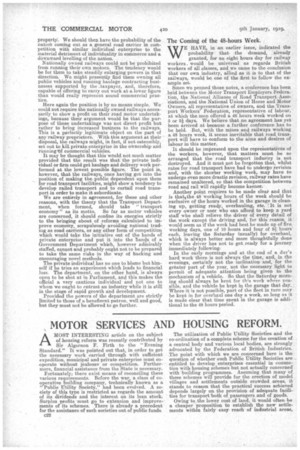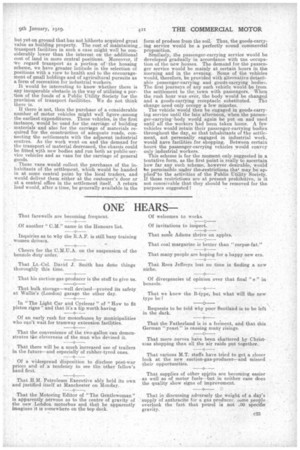MOTOR SERVICES AND HOUSING REFORM.
Page 2

Page 3

If you've noticed an error in this article please click here to report it so we can fix it.
AMOST INTERESTING article on the subject of housing reform was recently contributed by Sir Algernon F. Firth to the "Evening Standard." It was pointed out that in order to get the necessary work carried through with sufficient expedition, municipal and private enterprise must cooperate without iealousv or competition. Furthermore, financial assistance from the State is necessary.
Fortunately; there exist means of reconciling these various requirements. Before the war, a class of cooperative building company, technically known as a " Public Utility Society," had been evolved. A society of this type is restricted as regards the amount of its dividends and the interest on its loan stock. Surplus profits must go to extension and improvee meats of its schemes. There is already a precedent for the assistance of such societies out of public funds. c22 The utilization of Public Utility Societies and the co-ordination of a ceraplete scheme for the creation of a central body and various local bodies, are strongly advocated by the Federation of British Industries. The point with which we are concerned here is the question of whether such Public Utility Societies are entitled to develop enterprises essential in connection with housing schemes but not actually concerned with building programmes. Assuming that many of these schemes will provide for the erection of model villages and settlements outside crowded areas, it stands to reason that the practical success achieved depends largely on the provision of adequate facilities for transport both of passengers and of goods.
Owing to the lower cost of land, it would often be a cheaper proposition to establish the new settlements within fairly easy reach of industrial areas,
but yet on ground that has not. hitherto acquired great value as building property. The cost of maintaining transport facilities in such a case might well be considerably lower than the interest on the additional cost of land in more central positions. Moreover, if we regard transport as a portion of the housing scheme, we have greater latitude in the selection of positions with a view to health and to the encouragement of small holdings and of agricultural pursuits as a. form of recreation for industrial workers.
It would be interesting to know Ivhether there is any insuperable obstacle in the way of utilizing a portion of the funds of a Public Utility Society for the provision of transport iscilitites. We do not think there is.
If there is not, then the purchase of a considerable number of motor vehicles might well figure ,among the earliest expenditures. These vehicles, in the first instance, would be used for the carriage of building materials and also for the carriage of materials required lor the construction of adequate roads, connecting the settlements with the adjacent industrial centres. As the work went on and the demand for the transport Of material decreased, the-chassis could be fitted with new bodies and run both as public-service vehicles and as vans for the carriage of general goods.
These vans would collect the purchases of the inhabitants of the settlement, which would be handed in at some central point by the local traders, and would deliver them either at the customer's door or at a central office in the settlement itself. A return load would, after a time, be generally available in the
form of produce from the soil. Thus, the goods-carrying service would be a perfectly sound commercial proposition.
Similarly, the passenger-carrying service would be developed gradually in accordance with toe -occupation of the new houses. The demand for the passenger service would be mainly at certain hours in the morning and in the evening. Some of the vehicles would, therefore, be provided with alternative detachable passenger-carrying and goods-carrying bodies. The first journeys of any such vehicle would be from the settlement to the town with passengers. When the rush hour was over, the body would be change_d and a goods-carrying receptacle substituted. The change need only occupy a few minutes.
The vehicle would then be engaged in goods-carrying service until the late afternoon, when the passenger-carrying '.body would again be put on and used until all the workers had been taken home. A few vehicles would retain their passenger-carrying bodies throughout the day, so that inhabitants of the settlement, not personally engaged in industrial work, would nave facilities for shopping. Between certain hours the passenger-carrying vehicles would convey only industrial workers.
This scheme is for the moment only suggested in a tentative form, as the first point is really to ascertain how far any such scheme, however desirable, would be permissible under the-restrictions the may be appliecrto the activities of the Public Utility Society. If those restrictions are at present prohibitive, is it not conceivable that they should be removed for the purposes suggested ?






















